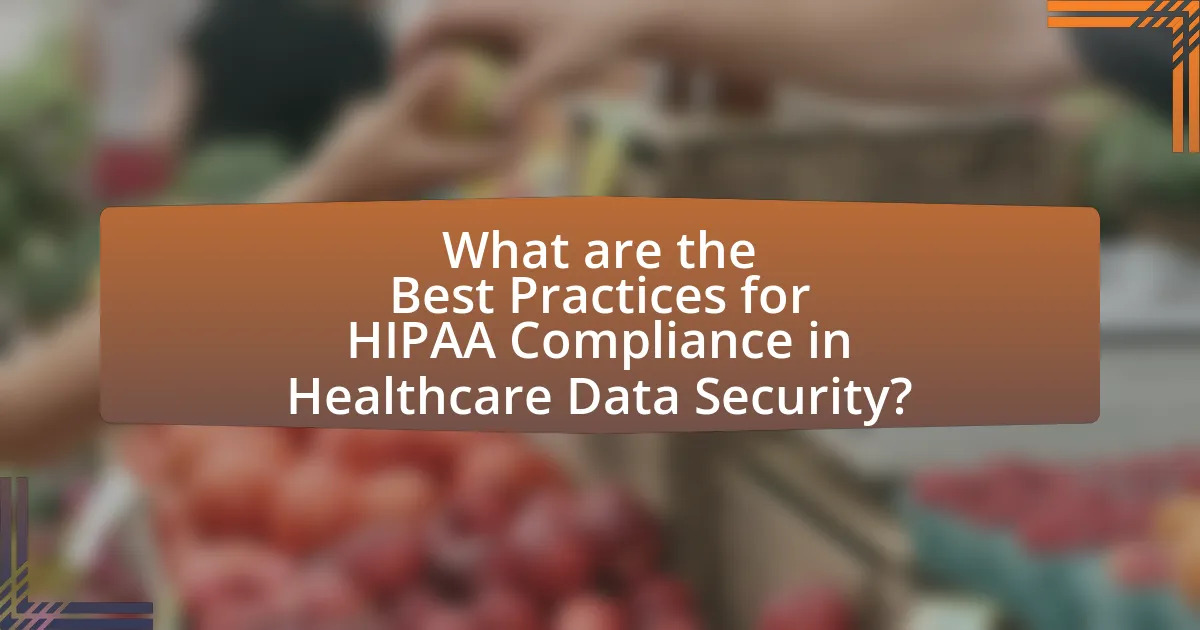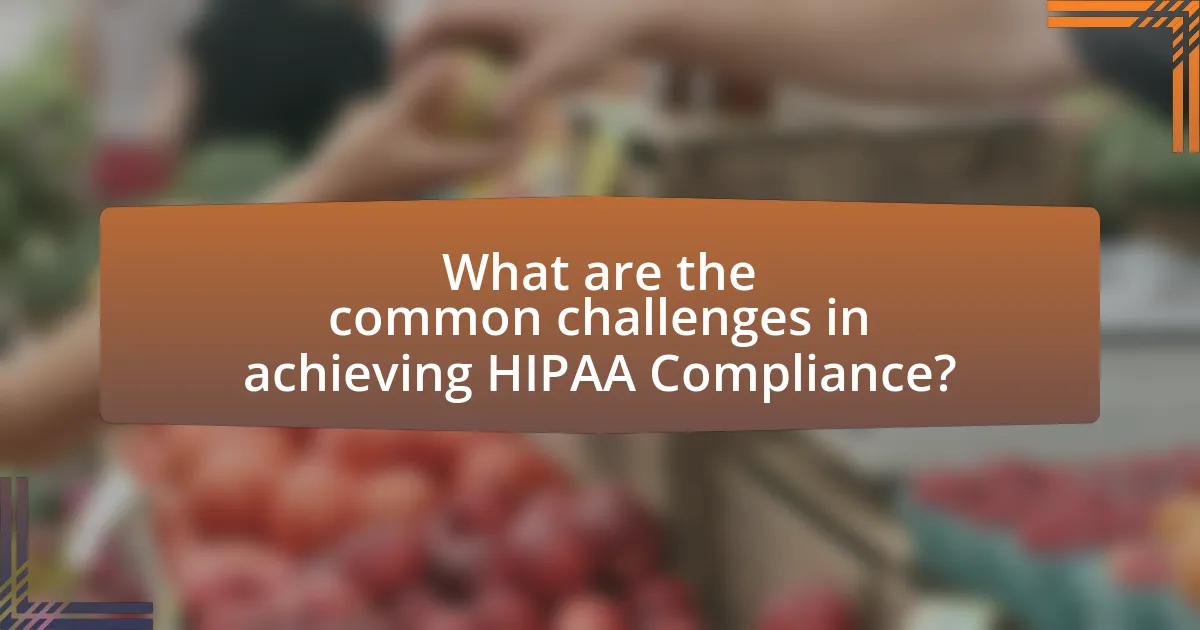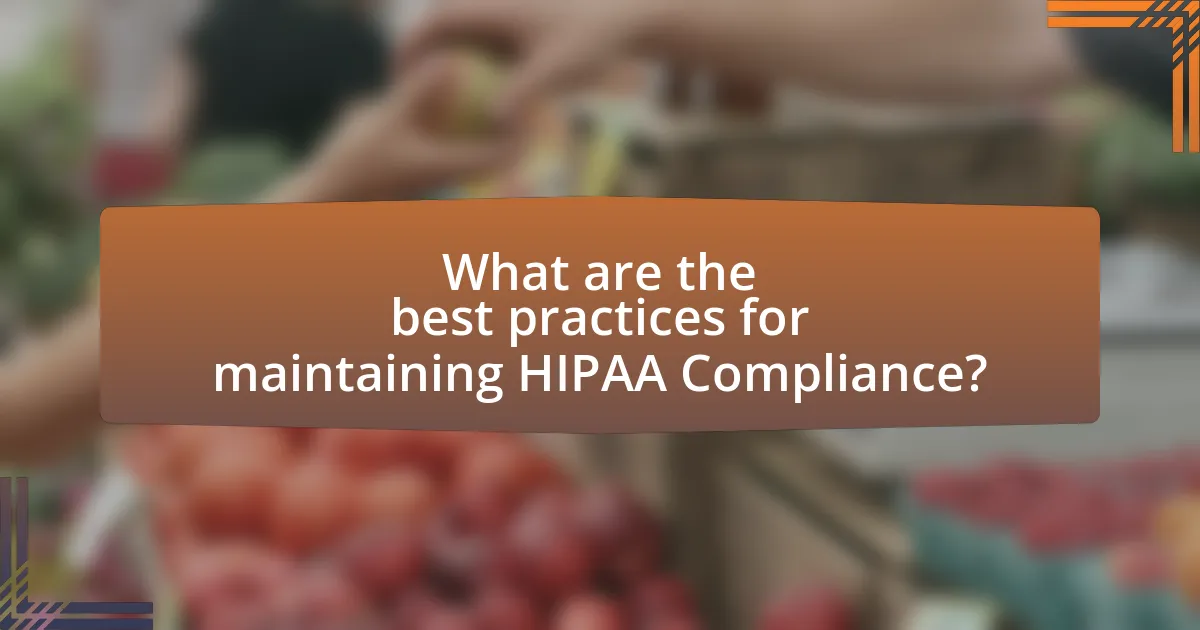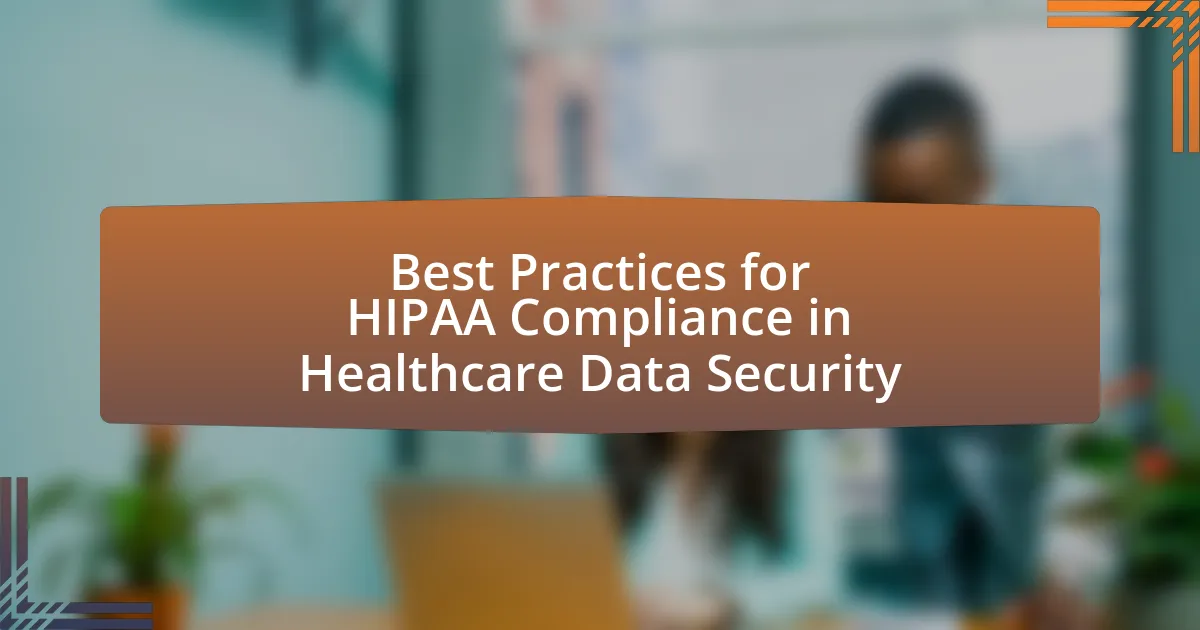The article focuses on best practices for HIPAA compliance in healthcare data security, emphasizing the importance of protecting patient health information. Key practices include conducting regular risk assessments, implementing strong access controls, ensuring data encryption, providing employee training, and maintaining proper documentation. The article outlines the critical nature of HIPAA compliance for healthcare organizations, detailing potential legal and financial consequences of non-compliance, as well as the essential components of HIPAA regulations such as the Privacy Rule and Security Rule. Additionally, it discusses the role of technology in supporting compliance efforts and highlights common challenges and pitfalls organizations face in achieving and maintaining HIPAA compliance.

What are the Best Practices for HIPAA Compliance in Healthcare Data Security?
The best practices for HIPAA compliance in healthcare data security include conducting regular risk assessments, implementing strong access controls, ensuring data encryption, providing employee training, and maintaining proper documentation. Regular risk assessments help identify vulnerabilities in systems and processes, allowing organizations to address potential threats proactively. Strong access controls limit data access to authorized personnel only, reducing the risk of unauthorized disclosures. Data encryption protects sensitive information both in transit and at rest, making it unreadable to unauthorized users. Employee training ensures that staff are aware of HIPAA regulations and best practices, fostering a culture of compliance. Proper documentation of policies, procedures, and incidents is essential for demonstrating compliance during audits and investigations. These practices collectively enhance the security of healthcare data and ensure adherence to HIPAA regulations.
Why is HIPAA Compliance Critical for Healthcare Organizations?
HIPAA compliance is critical for healthcare organizations because it ensures the protection of patient health information and maintains trust in the healthcare system. By adhering to HIPAA regulations, organizations safeguard sensitive data against breaches, which can lead to significant financial penalties; for instance, the Department of Health and Human Services can impose fines ranging from $100 to $50,000 per violation, with a maximum annual penalty of $1.5 million. Furthermore, compliance helps healthcare organizations avoid legal repercussions and enhances their reputation, as patients are more likely to seek care from providers that demonstrate a commitment to data security and privacy.
What are the potential consequences of non-compliance with HIPAA?
Non-compliance with HIPAA can result in significant legal and financial consequences for healthcare organizations. These consequences include civil penalties that can range from $100 to $50,000 per violation, with a maximum annual penalty of $1.5 million. Additionally, criminal penalties may apply, leading to fines and imprisonment for individuals who knowingly violate HIPAA regulations. For instance, the U.S. Department of Health and Human Services reported that in 2020, over $13 million was collected in HIPAA enforcement actions, highlighting the financial risks associated with non-compliance. Furthermore, non-compliance can damage an organization’s reputation, leading to loss of patient trust and potential loss of business.
How does HIPAA protect patient information?
HIPAA protects patient information through a set of regulations that establish standards for the privacy and security of health information. Specifically, HIPAA mandates that healthcare providers, insurers, and their business associates implement safeguards to ensure the confidentiality, integrity, and availability of protected health information (PHI). These safeguards include administrative, physical, and technical measures, such as access controls, encryption, and employee training on privacy practices. The enforcement of these regulations is backed by penalties for non-compliance, which can include fines and legal action, thereby reinforcing the importance of protecting patient information.
What are the key components of HIPAA Compliance?
The key components of HIPAA Compliance include the Privacy Rule, the Security Rule, and the Breach Notification Rule. The Privacy Rule establishes national standards for the protection of individuals’ medical records and personal health information, ensuring that such information is properly safeguarded. The Security Rule sets standards for the protection of electronic protected health information (ePHI), requiring covered entities to implement administrative, physical, and technical safeguards. The Breach Notification Rule mandates that covered entities notify affected individuals and the Department of Health and Human Services in the event of a data breach involving unsecured protected health information. These components collectively ensure the confidentiality, integrity, and availability of health information, as mandated by the Health Insurance Portability and Accountability Act of 1996.
What are the Privacy Rule and Security Rule in HIPAA?
The Privacy Rule and Security Rule in HIPAA are two critical components designed to protect patient information. The Privacy Rule establishes national standards for the protection of individually identifiable health information, allowing patients to control access to their medical records. It mandates that healthcare providers and organizations implement safeguards to ensure the confidentiality of patient data. The Security Rule complements the Privacy Rule by setting standards specifically for electronic protected health information (ePHI), requiring covered entities to implement administrative, physical, and technical safeguards to protect this data from unauthorized access and breaches. Together, these rules ensure comprehensive protection of patient information in healthcare settings.
How do the Administrative, Physical, and Technical safeguards work?
Administrative, Physical, and Technical safeguards work together to protect healthcare data by ensuring compliance with HIPAA regulations. Administrative safeguards involve policies and procedures that manage the selection, development, implementation, and maintenance of security measures, such as workforce training and access controls. Physical safeguards protect the physical facilities and equipment that store electronic health information, including facility access controls and workstation security. Technical safeguards involve technology and related policies that protect and control access to electronic health information, such as encryption and audit controls. These safeguards collectively mitigate risks to patient data, ensuring confidentiality, integrity, and availability as mandated by HIPAA.
What steps can healthcare organizations take to ensure HIPAA Compliance?
Healthcare organizations can ensure HIPAA compliance by implementing comprehensive risk assessments, establishing robust privacy and security policies, and providing ongoing employee training. Conducting regular risk assessments helps identify vulnerabilities in handling protected health information (PHI), which is essential for compliance. Developing and enforcing privacy and security policies ensures that all staff understand their responsibilities regarding PHI. Additionally, ongoing training programs keep employees informed about HIPAA regulations and best practices, reducing the likelihood of breaches. According to the U.S. Department of Health and Human Services, organizations that actively engage in these practices significantly lower their risk of non-compliance and potential penalties.
How can organizations conduct a risk assessment for HIPAA compliance?
Organizations can conduct a risk assessment for HIPAA compliance by systematically identifying and evaluating potential risks to the confidentiality, integrity, and availability of protected health information (PHI). This process involves several key steps:
- Identify PHI: Organizations must first determine what PHI they hold and how it is stored, processed, and transmitted.
- Assess Risks: Next, they should analyze potential threats and vulnerabilities that could impact PHI, including both internal and external risks.
- Evaluate Current Security Measures: Organizations need to review existing security controls and policies to determine their effectiveness in mitigating identified risks.
- Determine Likelihood and Impact: Each risk should be assessed for its likelihood of occurrence and potential impact on the organization and affected individuals.
- Develop a Risk Management Plan: Based on the assessment, organizations should create a plan to address identified risks, including implementing new security measures or policies as needed.
- Document Findings: All findings and actions taken should be documented to demonstrate compliance and for future reference.
- Review and Update Regularly: Organizations must regularly review and update their risk assessments to account for changes in technology, operations, and regulations.
These steps align with the guidelines set forth by the U.S. Department of Health and Human Services, which emphasizes the importance of ongoing risk assessments as part of a comprehensive HIPAA compliance strategy.
What training programs are essential for staff regarding HIPAA?
Essential training programs for staff regarding HIPAA include Privacy Rule training, Security Rule training, and Breach Notification training. Privacy Rule training educates employees on the handling of protected health information (PHI) and patient rights, while Security Rule training focuses on safeguarding electronic PHI through administrative, physical, and technical safeguards. Breach Notification training ensures staff understand the procedures for reporting and responding to data breaches. These programs are critical as they help organizations comply with HIPAA regulations, which mandate that covered entities provide training to their workforce to protect patient information and avoid penalties.
How can technology support HIPAA Compliance in data security?
Technology can support HIPAA compliance in data security by implementing encryption, access controls, and audit trails. Encryption protects sensitive patient data by converting it into a secure format that can only be accessed by authorized users, thereby reducing the risk of data breaches. Access controls ensure that only individuals with the necessary permissions can view or modify protected health information (PHI), which is essential for maintaining confidentiality. Audit trails provide a record of who accessed data and when, enabling organizations to monitor compliance and identify potential security incidents. According to the U.S. Department of Health and Human Services, these technological measures are critical components of the HIPAA Security Rule, which mandates safeguards to protect electronic PHI.
What role do encryption and access controls play in protecting data?
Encryption and access controls are critical in protecting data by ensuring that sensitive information is unreadable to unauthorized users and that only authorized individuals can access it. Encryption transforms data into a secure format that can only be decrypted with a specific key, thereby safeguarding it from breaches. For instance, the Health Insurance Portability and Accountability Act (HIPAA) mandates that healthcare organizations implement encryption to protect electronic protected health information (ePHI). Access controls, on the other hand, regulate who can view or use resources in a computing environment, ensuring that only individuals with the necessary permissions can access sensitive data. According to the U.S. Department of Health and Human Services, implementing robust access controls is essential for compliance with HIPAA regulations, as it helps prevent unauthorized access and potential data breaches.
How can healthcare organizations utilize secure communication tools?
Healthcare organizations can utilize secure communication tools by implementing encrypted messaging platforms that comply with HIPAA regulations. These tools enable healthcare professionals to share sensitive patient information securely, ensuring confidentiality and integrity of data. For instance, using platforms that offer end-to-end encryption protects messages from unauthorized access during transmission. Additionally, secure communication tools often include features such as user authentication and audit trails, which help organizations maintain compliance with HIPAA’s privacy and security rules. Studies indicate that organizations adopting these secure communication methods experience a significant reduction in data breaches, reinforcing the importance of secure communication in safeguarding patient information.

What are the common challenges in achieving HIPAA Compliance?
Common challenges in achieving HIPAA compliance include understanding the complex regulations, ensuring proper staff training, and maintaining secure electronic health records. Organizations often struggle with the intricacies of HIPAA’s Privacy and Security Rules, which require comprehensive knowledge to implement effectively. Additionally, inadequate training can lead to human errors that compromise patient data security, as studies show that 95% of cybersecurity breaches are due to human mistakes. Lastly, maintaining secure electronic health records necessitates ongoing investments in technology and regular audits, which can be resource-intensive for healthcare providers.
What are the most frequent compliance pitfalls for healthcare organizations?
The most frequent compliance pitfalls for healthcare organizations include inadequate staff training, failure to conduct regular risk assessments, and insufficient documentation of policies and procedures. Inadequate staff training often leads to employees being unaware of HIPAA regulations, resulting in unintentional breaches. Failure to conduct regular risk assessments can leave organizations vulnerable to security threats, as they may not identify potential weaknesses in their systems. Insufficient documentation of policies and procedures can create confusion and inconsistency in compliance efforts, making it difficult to demonstrate adherence to regulations during audits. These pitfalls are commonly reported in compliance audits and studies, highlighting the critical need for healthcare organizations to prioritize comprehensive training, regular assessments, and thorough documentation to maintain compliance with HIPAA standards.
How can organizations address the lack of staff training on HIPAA?
Organizations can address the lack of staff training on HIPAA by implementing comprehensive training programs that are mandatory for all employees. These programs should include regular updates on HIPAA regulations, practical scenarios, and assessments to ensure understanding. According to the U.S. Department of Health and Human Services, ongoing training is essential for compliance, as it helps staff recognize and mitigate risks associated with protected health information. Additionally, organizations can utilize online training modules and workshops to facilitate accessibility and engagement, ensuring that all employees are well-informed about their responsibilities under HIPAA.
What issues arise from outdated technology in relation to HIPAA compliance?
Outdated technology poses significant challenges to HIPAA compliance, primarily by increasing vulnerabilities to data breaches and compromising patient privacy. Systems that are not regularly updated may lack essential security features, making them susceptible to cyberattacks; for instance, the 2017 WannaCry ransomware attack exploited outdated systems, affecting healthcare organizations worldwide. Additionally, outdated technology often fails to support necessary encryption protocols, which are critical for protecting sensitive health information during transmission and storage. The inability to maintain compliance with HIPAA’s Security Rule can lead to substantial fines, as evidenced by the U.S. Department of Health and Human Services imposing over $100 million in penalties for non-compliance in recent years. Thus, reliance on outdated technology directly undermines the integrity of healthcare data security and compliance efforts.
How can organizations stay updated with HIPAA regulations?
Organizations can stay updated with HIPAA regulations by regularly reviewing the official guidance provided by the U.S. Department of Health and Human Services (HHS) and subscribing to updates from reputable healthcare compliance organizations. The HHS Office for Civil Rights (OCR) frequently publishes updates, FAQs, and resources that reflect changes in HIPAA regulations. Additionally, attending industry conferences, webinars, and training sessions focused on healthcare compliance can provide insights into the latest regulatory developments. Engaging with legal counsel specializing in healthcare law also ensures that organizations are aware of any legal interpretations or changes in enforcement practices related to HIPAA.
What resources are available for ongoing HIPAA education?
Ongoing HIPAA education resources include the U.S. Department of Health and Human Services (HHS) website, which offers comprehensive guidance and training materials on HIPAA regulations. Additionally, organizations such as the Health Care Compliance Association (HCCA) provide webinars, conferences, and certification programs focused on HIPAA compliance. The National Institute of Standards and Technology (NIST) also publishes guidelines that support HIPAA education, particularly in the context of data security. These resources are validated by their authoritative roles in healthcare compliance and their commitment to providing up-to-date information on HIPAA regulations.
How can organizations implement a continuous compliance monitoring system?
Organizations can implement a continuous compliance monitoring system by integrating automated tools that regularly assess adherence to HIPAA regulations. These tools can track data access, audit logs, and security incidents in real-time, ensuring that any deviations from compliance are promptly identified and addressed. For instance, utilizing software solutions that provide alerts for unauthorized access or data breaches can significantly enhance monitoring capabilities. According to the U.S. Department of Health and Human Services, regular risk assessments and audits are essential components of maintaining compliance, as they help organizations identify vulnerabilities and implement corrective actions.

What are the best practices for maintaining HIPAA Compliance?
The best practices for maintaining HIPAA compliance include conducting regular risk assessments, implementing strong access controls, ensuring proper employee training, and maintaining comprehensive documentation. Regular risk assessments help identify vulnerabilities in protected health information (PHI) handling, which is essential for compliance. Strong access controls limit PHI access to authorized personnel only, reducing the risk of data breaches. Employee training ensures that all staff members understand HIPAA regulations and their responsibilities, which is crucial for maintaining compliance. Comprehensive documentation of policies, procedures, and compliance efforts provides evidence of adherence to HIPAA requirements and can be critical during audits.
How can regular audits contribute to HIPAA Compliance?
Regular audits contribute to HIPAA compliance by systematically evaluating an organization’s adherence to privacy and security regulations. These audits identify vulnerabilities, ensure that policies are effectively implemented, and verify that staff are trained in compliance protocols. According to the U.S. Department of Health and Human Services, regular audits help organizations detect potential breaches and mitigate risks before they escalate, thereby maintaining the integrity of protected health information.
What should be included in a HIPAA compliance audit checklist?
A HIPAA compliance audit checklist should include the following key components: risk assessment, policies and procedures review, employee training records, business associate agreements, access controls, incident response plans, and documentation of compliance efforts.
The risk assessment evaluates potential vulnerabilities to protected health information (PHI) and ensures that appropriate safeguards are in place. Reviewing policies and procedures confirms that they align with HIPAA regulations. Employee training records demonstrate that staff are educated on HIPAA requirements. Business associate agreements ensure that third-party vendors comply with HIPAA standards. Access controls verify that only authorized personnel can access PHI. Incident response plans outline steps to take in the event of a data breach. Documentation of compliance efforts provides evidence of ongoing adherence to HIPAA regulations.
These components are essential for ensuring that healthcare organizations maintain compliance with HIPAA and protect patient information effectively.
How often should audits be conducted for effective compliance?
Audits should be conducted at least annually for effective compliance with HIPAA regulations. This frequency allows organizations to identify and address potential vulnerabilities in their healthcare data security practices. According to the U.S. Department of Health and Human Services, regular audits help ensure that covered entities and business associates are adhering to the required safeguards and can significantly reduce the risk of data breaches. Additionally, organizations may need to conduct more frequent audits if there are significant changes in operations, technology, or regulations, as these factors can impact compliance status.
What role does incident response play in HIPAA Compliance?
Incident response is critical for HIPAA compliance as it ensures that healthcare organizations can effectively manage and mitigate breaches of protected health information (PHI). By having a structured incident response plan, organizations can quickly identify, respond to, and recover from security incidents, thereby minimizing potential harm to patients and reducing the risk of regulatory penalties. The HIPAA Security Rule mandates that covered entities implement security measures to protect electronic PHI, and a robust incident response strategy is a key component of these measures, as it helps organizations demonstrate their commitment to safeguarding sensitive data and complying with federal regulations.
How should organizations prepare for a data breach under HIPAA regulations?
Organizations should prepare for a data breach under HIPAA regulations by implementing a comprehensive risk management plan that includes regular risk assessments, employee training, and incident response protocols. Regular risk assessments help identify vulnerabilities in systems and processes, allowing organizations to address potential weaknesses proactively. Employee training ensures that staff are aware of HIPAA requirements and understand their role in safeguarding protected health information (PHI). Additionally, having a well-defined incident response plan enables organizations to respond swiftly and effectively to breaches, minimizing potential harm and ensuring compliance with HIPAA’s notification requirements. These practices are essential for maintaining the confidentiality, integrity, and availability of PHI, as mandated by HIPAA regulations.
What steps should be taken immediately following a HIPAA violation?
Immediately following a HIPAA violation, the first step is to contain the breach to prevent further unauthorized access to protected health information (PHI). This involves identifying the source of the violation, securing the affected systems, and limiting access to the compromised data. Next, the organization must conduct a risk assessment to evaluate the nature and extent of the violation, including the types of PHI involved and the potential impact on affected individuals.
Following the assessment, the organization should notify affected individuals as required by HIPAA regulations, informing them of the breach and the steps being taken to mitigate any harm. Additionally, the organization must report the violation to the Department of Health and Human Services (HHS) if the breach affects 500 or more individuals, or to the media if it affects a significant number of individuals.
Finally, the organization should implement corrective actions to address the vulnerabilities that led to the violation, which may include revising policies, providing additional staff training, and enhancing security measures to prevent future breaches. These steps are essential for compliance with HIPAA regulations and for maintaining the trust of patients and stakeholders.
What practical tips can healthcare organizations implement for HIPAA Compliance?
Healthcare organizations can implement several practical tips for HIPAA compliance, including conducting regular risk assessments, training employees on privacy policies, and ensuring secure electronic communications. Regular risk assessments help identify vulnerabilities in data handling and storage, allowing organizations to address potential breaches proactively. Employee training ensures that all staff members understand HIPAA regulations and the importance of protecting patient information, which is crucial given that human error is a leading cause of data breaches. Additionally, using secure methods for electronic communications, such as encrypted emails and secure messaging platforms, protects sensitive patient data from unauthorized access. These strategies collectively enhance compliance and safeguard patient information effectively.
How can organizations foster a culture of compliance among staff?
Organizations can foster a culture of compliance among staff by implementing comprehensive training programs that emphasize the importance of regulations like HIPAA. These training sessions should be regular, interactive, and tailored to the specific roles of employees, ensuring that they understand their responsibilities regarding patient data protection. Research indicates that organizations with ongoing compliance training see a 50% reduction in violations compared to those with infrequent training (Source: Compliance Week, 2021). Additionally, establishing clear policies and procedures, along with accessible resources for staff to consult, reinforces the commitment to compliance. Regular audits and feedback mechanisms can further enhance accountability and encourage adherence to compliance standards.
What are the best practices for documenting compliance efforts?
The best practices for documenting compliance efforts include maintaining comprehensive records of policies, procedures, and training related to HIPAA regulations. Organizations should ensure that documentation is clear, accessible, and regularly updated to reflect any changes in compliance requirements. Additionally, conducting regular audits and assessments of compliance documentation helps identify gaps and areas for improvement. Evidence of compliance, such as training attendance records and incident reports, should be systematically organized and stored securely. These practices not only facilitate adherence to HIPAA standards but also provide a clear audit trail that can be referenced during compliance reviews or investigations.
